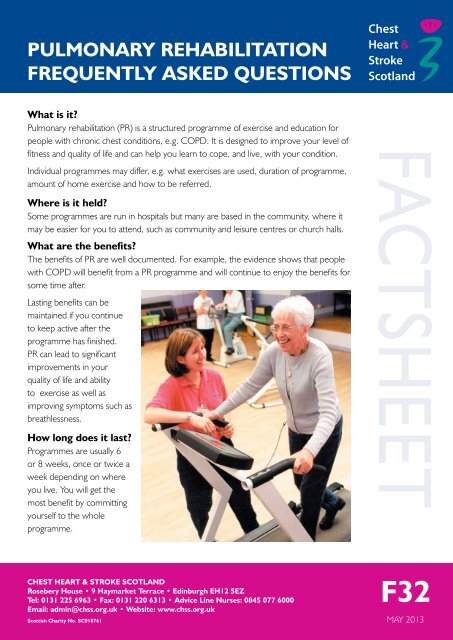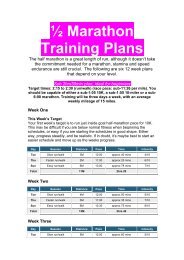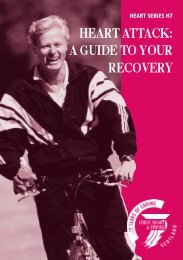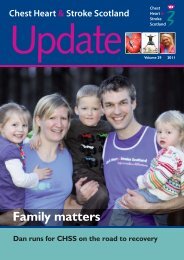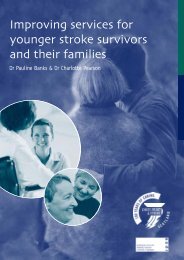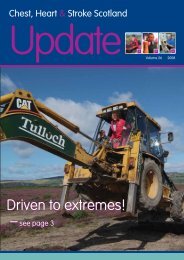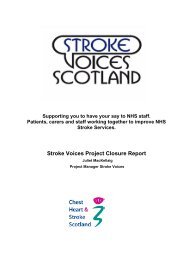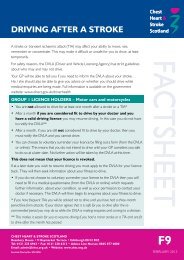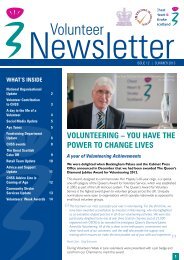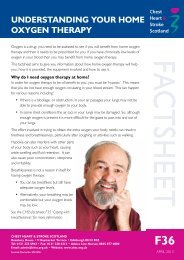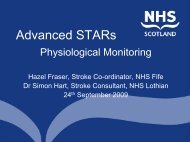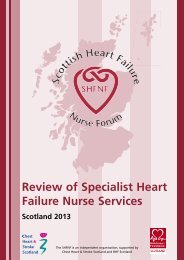pulmonary rehabilitation frequently asked questions - Chest Heart ...
pulmonary rehabilitation frequently asked questions - Chest Heart ...
pulmonary rehabilitation frequently asked questions - Chest Heart ...
Create successful ePaper yourself
Turn your PDF publications into a flip-book with our unique Google optimized e-Paper software.
PULMONARY REHABILITATIONFREQUENTLY ASKED QUESTIONSWhat is it?Pulmonary <strong>rehabilitation</strong> (PR) is a structured programme of exercise and education forpeople with chronic chest conditions, e.g. COPD. It is designed to improve your level offitness and quality of life and can help you learn to cope, and live, with your condition.Individual programmes may differ, e.g. what exercises are used, duration of programme,amount of home exercise and how to be referred.Where is it held?Some programmes are run in hospitals but many are based in the community, where itmay be easier for you to attend, such as community and leisure centres or church halls.What are the benefits?The benefits of PR are well documented. For example, the evidence shows that peoplewith COPD will benefit from a PR programme and will continue to enjoy the benefits forsome time after.Lasting benefits can bemaintained if you continueto keep active after theprogramme has finished.PR can lead to significantimprovements in yourquality of life and abilityto exercise as well asimproving symptoms such asbreathlessness.How long does it last?Programmes are usually 6or 8 weeks, once or twice aweek depending on whereyou live. You will get themost benefit by committingyourself to the wholeprogramme.FACTSHEETCHEST HEART & STROKE SCOTLANDRosebery House • 9 Haymarket Terrace • Edinburgh EH12 5EZTel: 0131 225 6963 • Fax: 0131 220 6313 • Advice Line Nurses: 0845 077 6000Email: admin@chss.org.uk • Website: www.chss.org.ukScottish Charity No. SC018761F32MAY 2013
Who runs it?Every programme is organised and coordinated by a health professional – usually a nurseor a physiotherapist. They will be at every class and do your initial assessment.FACTSHEETHow will I get there?Your programme coordinator might be able to arrange transport for you if you need it.Your local area may have transport schemes such as Dial a Ride, TaxiCards or VolunteerCar Schemes you could apply to. If you have difficulty arranging transport please contactthe CHSS Advice Line nurses for assistance.How will I know what I can do?You will have an initial assessment which will show the coordinator how well you cantolerate increased physical activity (exercise). This will be used as a baseline to show howwell you improve over the weeks.The assessment is likely to be in the form of a walking test. You will be <strong>asked</strong> to walk fora measured distance over a period of time. Your oxygen levels will be measured by pulseoximetry (a small device placed on your thumb will measure this). Your symptoms willbe monitored and used as a baseline for future exercise.What will I actually do?Exercise is the core of the programme and is individually ‘prescribed’ for you based onyour original assessment. As you progress you will gradually increase what you do.This will involve ‘endurance work’, such as walking or using an exercise bike, and‘strengthening work’ using other equipment, such as gentle weights, for strengtheningyour arms and legs. Your coordinator will supervise you closely, ensure your safety at alltimes and reassure you throughout.What should I wear?You should wear loose comfortable clothing and comfortable flat shoes such as trainers.What happens apart from exercise?After each exercise session there are health education talks. These cover all aspectsof lung disease, from the normal functioning of your lungs and the disease process, tocoping strategies such as relaxation techniques and breathing control. A multidisciplinaryteam of health professionals may be involved. The team may include a physiotherapist,dietician, occupational therapist, psychologist, pharmacist, social worker, specialistmedical and nursing staff.What sort of people go?People of all ages and all walks of life attend PR.
Who is eligible for PR?PR should be offered to people with moderate to severe COPD. This means that youare affected by your illness enough to be aware that it is affecting your life on a daily basis.PR is not suitable if you are unable to walk, have unstable angina or have had a recentheart attack. By accepting a place you should commit yourself to completing the wholeprogramme.How do you get referred?If there is a class in your area you may get referred by your GP, nurse, physiotherapist orhospital consultant. Ask one of these health professionals if you think PR could help you.How many people will be there?Classes are usually small in number. Your initial assessment will be done alone with thecoordinator.Can I still go if I’m breathless?Absolutely! One of the aims of the programme is to teach you how to manage yourbreathlessness and not to be afraid to be active because of it.In COPD, you may be afraid that exercise will make you more breathless, or thatbreathlessness may be doing you some harm. This isn’t true! By gradually building upthe amount of exercise you do, you can help to improve your breathing. You will alsostrengthen your arms, legs, trunk and heart. This will in turn make everyday activities lesstiring and less demanding of your energy. This reverses the so-called ‘cycle of inactivity’where the less you do, the less you become able to do. It has been proven that workingthe lungs through exercise actually improves symptoms like breathlessness and energy loss.FACTSHEET


